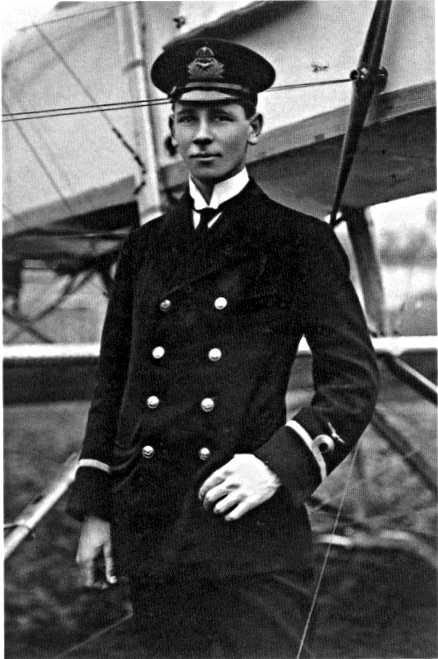 |
| Lilliput March 1957, p.24 Warneford's plane is caught in the exploding Zeppelin's wake |
Raymond Sheppard illustrated the story of "Warneford VC" written by John Prebble, in Lilliput March 1957. The story of the flying ace who destroyed a Zeppelin and changed attitudes to this gigantic bombing machine is told in exciting prose.
"There was less than seven hours of darkness on the night of Sunday, June 6 1915, and the moon was in its last quarter. North-west Europe was experiencing a hot summer and the peak temperature in England that noon had been 90 degrees [32.2 degrees Celsius]"

"Reginald Warneford portrait 3".
BACKGROUND
Count von Zeppelin built his first airship in 1894 and this format of travel became very popular before the war as a passenger transport. But the German forces saw the military potential and so began 'total war' in which civilians became causalities for the first time. By 1916 defences in Britain against this aerial attack got better through the tracking of radio signals, the use of searchlights and sending attack aircraft after them. They were extremely sensitive to explosions as they were filled with hydrogen. "Zeppelin raids were called off in 1917, by which time 77 out of the 115 German Zeppelins had been shot down or totally disabled. Raids by heavier than air bombers continued, however. By the end of the war over 1500 British citizens had been killed in air raids." ----http://www.nationalarchives.gov.uk/education/resources/zeppelin-raids/
 |
| Lilliput March 1957 cover |
 |
| Lilliput March 1957, p.22 Searchlights spot a Zeppelin above St. Paul's Cathedral |
"The picture of a pencil-slim object, slow moving in the night - licked by searchlights"
 |
| Lilliput March 1957, p.23 A Zeppelin crosses the English Channel with a boat in the background |
 |
| Lilliput March 1957, p.23 Warneford stands by his aircraft |
 |
| Lilliput March 1957, p.24 2 planes attack the Zeppelin |
As well as blowing up the highly volatile German airship, the resultant explosion knocked Warneford's plane out so he had to put down behind enemy lines. He attempted to repair his ship and succeeded in returning to base. Warneford gained two awards for this brave feat: the Victoria Cross and the Knight's Cross of the Légion d’honneur from the French Army Commander in Chief, General Joffre.
 |
| Lilliput March 1957, p.25 The Zeppelin catches fire whilst a bi-plane pursues |
Sadly Warneford didn't live long enough to revel in the glorious praise he received, as he died, ironically, carrying a passenger when transporting a plane from Buc, in Northern France for delivery at Veurne, Belgium. The tragic collapse of a wing on his second flight in this aircraft killed his passenger an American journalist, Henry Beach Newman, and led to Warneford's own death shortly after from injuries sustained in the crash from 200 feet.
 |
| Lilliput March 1957, p.25 The Zeppelin is pursued by Warneford |
The London Gazette of 11 June 1915 states (on page 5635 of Issue 29189):
Admiralty, 10th June, 1915 .
The KING has been graciously pleased to approve of the grant of the Victoria Cross to Flight Sub-Lieutenant Reginald Alexander John Warneford, Royal Naval Air Service, for the conspicuous act of bravery specified below:
For most conspicuous bravery on the 7th June, 1915, when he attacked and, single-handed, completely destroyed a Zeppelin in mid-air. This brilliant achievement was accomplished after chasing the Zeppelin from the coast of Flanders to Ghent, where he succeeded in dropping his bombs on to it from a height of only one or two hundred feet. One of these bombs caused a terrific explosion which set the Zeppelin on fire from end to end, but at the same time overturned his Aeroplane and stopped the engine. In spite of this he succeeded in landing safely in hostile country, and after 15 minutes started his engine and returned to his base without damage.
 |
| Lilliput March 1957, p.26 The LZ 37 Zeppelin's gondola |
 |
| Lilliput March 1957, p.26 Warneford's Morane-Saulnier |
The Daily Mail reported in 2013 how Warneford's name was sadly omitted in a roll call of Victoria Cross heroes due to his "being born abroad" (Darjeeling, India) but the carved memorial stone in Brompton Cemetery, London was seen at his funeral by thousands of mourners and is still there.
 |
| Lilliput March 1957, p.27 The Zeppelin explodes over Ghent, Belgium |
You can see Warneford's Victoria Cross at the Fleet Air Arm Museum in Yeovil, Somerset, England where from 5 June to 2 January 2016 an exhibition tells Warneford's story.
As can be seen below, Warneford's memorial in Brompton Cemetery has the famous scene carved in the face.

"Brompton Cemetery, London 37" by Edwardx - Own work.
UPDATE
I let the Fleet Air Arm Museum know about the article and got this back:
My colleague tells me that following pressure on the government department responsible for allocation of the VC memorial paving slabs, Rex Warneford is being honoured with at least one. His former school, King Edward VI School in Stratford on Avon has one, and we think that Exmouth may have won their fight for one, too.
Many thanks to Paul Liss for his generosity in supplying copies of the original art for four of the pieces above. Explore more of Raymond Sheppard's work on Paul's website at http://www.lissfineart.com/0art99_Raymond+Sheppard.htm . All other scans are by myself,
Norman Boyd
No comments:
Post a Comment